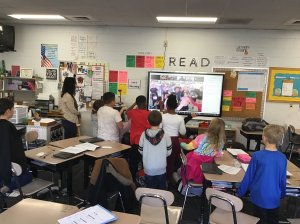Using Live Video Streams to Give Your Students the World
Video feeds from faraway locales can expand students’ horizons when their world feels small and constricted.
Your content has been saved!
Go to My Saved Content.The whole world has been in pandemic mode for almost an entire year. If we were to ask our students to list things they missed from pre-Covid life, they might include travel. Prior to the pandemic, students were able to link classroom learning to outside experiences like visiting an aquarium, picking apples at an orchard, or even learning to appreciate a different culture through international travel. Providing students with opportunities to investigate the world around them, use their curiosity to explore new ideas, and interact with students from different cultures prepares them for future work where they can competently tackle issues that demand a global solution.
Although field trips and travel are paused, with a computer, webcam, and the internet, we can still offer these global experiences to students in our hybrid classroom. These experiences will also be valuable when kids return to school full-time, since many of these destinations were unavailable to most students even before the pandemic.
3 Free Resources to Incorporate Livestreams Into Your Classroom
1. EarthCam: Livestreams are webcams broadcasting from locations around the world. EarthCam has streams available in all 50 states and many international locations. My personal favorite is Camp Kuzuma in Botswana. If you live in the Eastern time zone and access this camera in the morning, you may be lucky enough to see a herd of elephants drinking at the watering hole. Many of the livestreams have audio, which allows your students to hear the animals and experience the languages and sounds of international locations. They also feature the current temperature and time. This provides an opportunity to discuss time zones and track temperature.
There are many ways to incorporate livestreams into your lessons. Use livestreams to analyze ecosystems, build background knowledge, discuss life cycles, compare and contrast architecture, explore famous battlefields, and calculate distances between locations. You can even challenge your students to visit 50 states in 50 days or as a class travel the world in 30 days—the possibilities are endless.
2. National Geographic Explorer Classroom: National Geographic is a trusted resource in many classrooms around the world. Explorer Classroom is a YouTube live show that connects explorers to your students. These explorers include scientists, archaeologists, and marine biologists who tell their stories and share life experiences with students. They connect the real world to classroom content. On the Explorer Classroom website, teachers can filter by age and language to find the session that fits their students the best. In addition, teachers are provided a user guide to help prepare students for the experience. Students from around the world can watch the livestream on YouTube and type questions during the stream. Explorer Classroom also gives students the chance to be live with the explorer. The first six student groups to register are featured on camera and have the chance to ask the explorer questions directly.
Last year, I worked with a fourth-grade classroom, and we went live with a veterinarian from the Rwanda Wildlife Conservation Association and learned about their efforts to save grey crowned cranes. We were given a tour of the conservation center. We met the employees and even watched the veterinarian as he did an examination on a crane. It was an amazing experience.

3. Exploring by the Seat of Your Pants: Since September 2015, Exploring by the Seat of Your Pants has been connecting students with scientific experts from around the globe. Much like Explorer Classroom, Exploring by the Seat of Your Pants offers livestream sessions over Zoom where students can connect with experts, ask questions, and go on a virtual field trip. Students can watch the livestream on YouTube or Facebook Live. As with Explorer Classroom, teachers can register their class for a camera spot where students will be able to speak directly to the expert. They also offer other experiences, such as their #BackyardBio, where students use the iNaturalist and Seek apps to go outside, take pictures, and identify the biodiversity around them. They then upload their findings to the iNaturalist page and can join live events to share what they found.
Livestreams give us a fantastic glimpse into the world around us. Not only do they expose students to new places and ideas, but through shared experiences, students learn from classmates who are sitting next to them or an ocean away.
